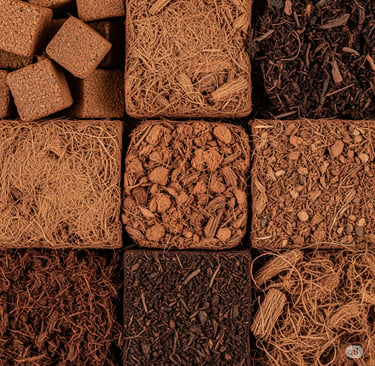🔥 Types of Cocopeat on the Market: Which One is Best for You?
coconusaindo
7/27/20253 min read


If you've dipped your toes into the world of hydroponics, container gardening, or even just soil amendments, you've likely come across cocopeat. But did you know there isn't just one type? Understanding the different forms of cocopeat available can significantly impact your gardening success.
A study by Indrawan, Gunadi, & Wiraatmaja (2021) on melon cultivation highlighted how various planting media types can affect crop yield. While their research focused on different media broadly, it underscores the importance of choosing the right substrate for optimal plant performance—a principle that applies directly to selecting the best cocopeat for your needs.
🌿 Understanding Cocopeat: Beyond Just "Dust"
Cocopeat, also known as coco coir or coconut fiber dust, is derived from coconut husks. The processing of these husks yields various textures, leading to different forms of cocopeat, each with unique characteristics ideal for specific horticultural applications.
Choosing the right type of cocopeat depends on your plant's needs, your growing method, and your personal preferences.
✅ Common Types of Cocopeat and Their Uses
Let's break down the most prevalent forms of cocopeat you'll find on the market:
1. Cocopeat Powder (Fine Grade)
Description: This is the most common form, resembling fine, brown sawdust. It's made from the pith of the coconut husk, ground into a fine consistency.
Characteristics: Excellent water retention and high porosity. It's often highly compressed into bricks or bales for shipping.
Best For:
Seed starting: Its fine texture provides good seed-to-medium contact, making it ideal for seed germination.
Microgreens: Perfect for shallow trays where consistent moisture is key.
Potting mixes: A primary component in many soilless potting mixes, often blended with other materials.
Hydroponic systems (certain types): Suitable for drip systems or NFT where a fine, consistent medium is preferred.
2. Coco Chips (Coarse Grade)
Description: These are larger, irregularly shaped pieces of coconut husk, offering a coarser texture than cocopeat powder.
Characteristics: Provides superior aeration and excellent drainage due to larger air pockets. It retains less water than fine cocopeat but still offers good moisture capacity.
Best For:
Orchids and Epiphytes: Mimics their natural growing environment by providing good air circulation around roots.
Hydroponic systems (DWC, Ebb & Flow): Prevents waterlogging and ensures roots get plenty of oxygen.
Drainage layers: Can be used at the bottom of pots to improve drainage.
Soil aeration: Blended into heavy soils to lighten them and improve air flow.
3. Coco Fiber (Long Strands)
Description: These are the longer, stringy fibers extracted from the coconut husk.
Characteristics: Primarily used for its structural integrity. Offers excellent aeration and drainage, providing physical support.
Best For:
Lining hanging baskets: Its fibrous nature prevents medium from falling out while allowing drainage.
Vertical gardens: Provides structural support for plants.
Mulching: Can be used as a decorative and moisture-retaining mulch.
Custom growing mixes: Added for enhanced aeration and structure.
4. Coco Grow Bags/Slabs
Description: Pre-packaged bags or slabs made primarily from compressed cocopeat powder, often with a mix of coco chips. Designed for specific crops.
Characteristics: Convenient, consistent, and usually come with pre-cut planting holes. Ideal for large-scale commercial growing operations.
Best For:
Greenhouse cultivation: Tomatoes, cucumbers, peppers, strawberries.
Hydroponic systems: Offers a contained and easy-to-manage growing environment.
💡 Which Cocopeat is Best for Your Plants?
The "best" type of cocopeat isn't universal; it's about matching the medium to your specific needs, as the Indrawan et al. (2021) study implicitly suggests with their focus on media types for melon cultivation.
For high water retention and seed starting: Fine cocopeat powder is generally your best bet.
For excellent drainage and aeration (e.g., orchids, hydroponics): Coco chips or blends incorporating them are ideal.
For structural support and custom mixes: Consider adding coco fiber.
For convenience and commercial scale: Coco grow bags offer an efficient solution.
Many premium potting mixes available today are blends of these different cocopeat types, often combined with perlite, vermiculite, or compost, to achieve an optimal balance of water retention, drainage, and aeration for various plant types.
📈 The Future of Sustainable Growing Media
As demand for sustainable agricultural practices grows, cocopeat in all its forms will continue to be a vital component. Its versatility and eco-friendly nature position it as a leading renewable growing medium for gardeners and commercial growers worldwide. Understanding its different types empowers you to make informed decisions for healthier plants and more efficient resource use.
📌 Reference
Indrawan, I. K. A., Gunadi, I. G., & Wiraatmaja, I. W. (2021). Pengaruh Jenis Media Tanam dan Varietas terhadap Hasil Tanaman Melon (Cucumis melo L.) pada Sistem Irigasi Tetes. Jurnal Agroekoteknologi Tropika, Vol. 10(3), pp. 400–408.
🚀 Ready to Elevate Your Garden with Cocopeat?
Are you a gardener seeking a superior and sustainable growing medium? Or a commercial grower looking for a clean, efficient, and eco-friendly alternative for your plants?
💼Coco Nusa Indo is here to connect you directly with vetted local producers in Indonesia—no hassle, no middlemen. As a neutral and trusted independent broker, we help you source better, faster, and more reliably.
🔗 Get in touch today at www.coconusaindo.com and let us help you find the best cocopeat straight from the source.
🌱 Transforming agricultural waste into thriving gardens.
Our social media
Connecting local producers with global markets.
Contact us
Email Us
Coconusaindo © 2025. All rights reserved.
